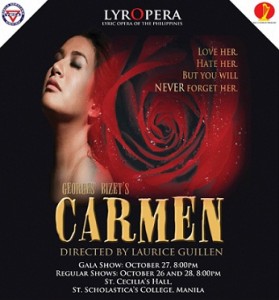By PABLO A. TARIMAN
 WHEN Lyric Opera of the Philippines presents Bizet’s “Carmen” on October 26, 27 and 28 at the St. Cecilia’s Hall, local opera lovers will have a glimpse of Camille Lopez Molina and Ana Feleo in the title roles with the Don Joses of Abdul Candao and Randy Gilongo directed by Laurice Guillen.
WHEN Lyric Opera of the Philippines presents Bizet’s “Carmen” on October 26, 27 and 28 at the St. Cecilia’s Hall, local opera lovers will have a glimpse of Camille Lopez Molina and Ana Feleo in the title roles with the Don Joses of Abdul Candao and Randy Gilongo directed by Laurice Guillen.
In her Director’s Notes, Guillen, who will be directing an opera for the first time, said, “ It is this production’s intent to be faithful to Bizet’s Realism, a movement he introduced into the opera with his work, Carmen. Its lumpen characters, the low morals of its main protagonists, its subject matter, the violent death in the end are the classic elements of this 19th century Realist movement. Thus, while the Lyropera’s staging of Bizet’s Carmen is stylized, the performance is realistic, character-driven and evocative of its atmosphere, theme and environment.”
It’s been 26 years since the last Carmen was seen in Metro Manila and it featured the unforgettable portrayal of Isola Jones in the title role and with the Don Jose of tenor Noel Velasco, the country’s first and last winner of the Luciano Pavarotti International Voice Competition.
Singing the signature aria, “Habanera” in that 1986 performance, Jones at once communicated she was no ordinary Carmen. She is Carmen. For three straight nights, Manila opera lovers feasted on a definitive Carmen which she also sang at the Met with Placido Domingo as Don Jose.
The last act was memorable for its dramatic tension in the confrontation scene. Jones’s voice throbbed with animal fury as she replied a firm no to Don Jose’s (Velasco’s) imprecations. Velasco, bearded for the part, revealed a ringing tone that intensified the evening’s high drama. Velasco’s “Flower aria” was also several notches superior to the versions of Richard Knees and Edgardo Sensi. who wobbled in the most sensitive part of the piece.
Staged in Manila by the Ambassadors of Opera of New York, the 1986 Carmen showed off the best of the American and Filipino co-production venture. That co-production also saw the first Carmen of the then 25-year old Amy Bonnevie and the Don Jose of Edgardo Sensi.
As with most first-timers, Bonnevie showed mere promise and one wished she projected more that she did. She was a classic case of those pushed into the role and emerging with nothing but a raffled budge of courage to show for the effort.
But as the Met opera coach Joan Dornemann said, “The reason why singers need so many performances is that there is nothing like the stage to give you the experience and to help you grow. Singers can’t grow in the studios. They need the stage, the productions and the performances. I think that what everybody has seen is the beginning of a very fine Don Jose in Noel Velasco.”
 That 1986 CCP Carmen was Jones’s 20th and what the Filipinos saw was her own idea of the Bizet heroine.
That 1986 CCP Carmen was Jones’s 20th and what the Filipinos saw was her own idea of the Bizet heroine.
“As a character,” she said then, “I see Carmen as very classy, not vulgar. She has to have this kind of hypnotic charm that will make men do what when they are in their right minds, will never do. And you can’t let men do that if you are vulgar about it.
The mezzo-soprano is of American Indian and African American descent and who started singing at age four. When she heard Leontyne Price at age 11, she begged her mother to buy a recording. It was at that juncture that she decided to become an opera singer.
Commented Dornemann about the Philippine Madrigal Singers and the Las Pinas Boys Choir which were part of the ensemble for the 1986 Carmen: “The singers and the choruses have the most beautiful voices. I think the heritage of this country has something special for music. IN the countries we’ve been to, I think the Filipinos have the most gifted musical talent.”
Before that 1986 “Carmen,” the Bizet opera was heard in Pilipino version in 1979 also at the Cultural Center of the Philipines with the soprano Conching Rosal (1926-1985) as the Bizet heroine. It featured the Escamillo of the late baritone Gamaliel Viray.
The first Filipino to sing Carmen and bring it to international audiences was the Silay City-born Conchita Gaston who died on June 11, 1984 in Holland. She died 34 years after her triumphant Carmen in New York.
In the late 50s, American critic and musicologist Deems Taylor wrote: “There may be a better Carmen than Conchita Gaston, but I haven’t heard one.”
Lyric Opera of the Philippines pointed out the purpose of its initial production is to revive the golden age of opera in the Philippines, and to recognize and emulate the contributions of local opera icons like Irma Potenciano, Conching Rosal, Gloria Coronel, Armida Siguon-Reyna, Salvacion Yniguez, Mercedes Matias Santiago, Sylvia La Torre, Fides Cuyugan-Asencio, Mamerto Villaba, Gamaliel Viray, Manny Gregorio, and Aurelio Estanislao, among others.